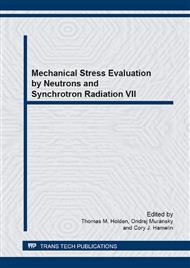[1]
I. Kelbassa, A. Gasser, K. Wissenbach, Laser cladding as a repair technique for blisk out of titanium and nickel base alloys used in aero engines, in: M. Brandt, E. Harvey (Eds.) 1st international confernce on application of laser and optics2004.
DOI: 10.2351/1.5056104
Google Scholar
[2]
K.H. Richter, S. Orban, S. Nowotny, Laser cladding of the titanium alloy Ti6242 to restore damaged blades, Proceedings of the 23rd international congress on applications of lasers and electro-optics2004.
DOI: 10.2351/1.5060222
Google Scholar
[3]
A. Steuwer, M. Dumont, M. Peel, M. Preuss, P.J. Withers, The variation of the unstrained lattice parameter in an AA7010 friction stir weld, Acta Materialia, 55 (2007) 4111-4120.
DOI: 10.1016/j.actamat.2007.01.024
Google Scholar
[4]
H.K.D.H. Bhadeshia, Developments in Martensitic and Bainitic Steels: Role of The Shape Deformation, Materials Science and Engineering A, 378 (2004) 34-39.
DOI: 10.1016/j.msea.2003.10.328
Google Scholar
[5]
H. Murakawa, M. Beres, C.M. Davies, S. Rashed, A. Vega, m. Tsunori, K.M. Nikbin, D. Dye, Effect of low transformation temperature weld filler metal on welding residual stress, Science and Technology of Welding and Joining, 15 (2010) 393-399.
DOI: 10.1179/136217110x12714217309614
Google Scholar
[6]
R. Cottam, V. Luzin, Q. Liu, Y.C. Wong, J. Wang, M. Brandt, Investigation into Heat Treatment and Residual Stress in Laser Clad AA7075 Powder on AA7075 Substrate, Metallorgaphy Microstructure and Analysis, (2013).
DOI: 10.1007/s13632-013-0080-x
Google Scholar
[7]
R. Cottam, V. Luzin, Q. Lui, N. Matthews, Y.C. Wong, M. Brandt, Stress Relief Heat Treatment for Laser Cladding Repair of Ti-6Al-4V Aircraft Components, 15th International Aerospace Congress, Melbourne, 2013, pp. #191.
Google Scholar
[8]
R. Cottam, K. Thorogood, Q. Liu, Y. Wong, M. Brandt, The Effect of Laser Cladding Deposition Rate on Residual Stress Formation in Ti-6Al-4V Clad Layers, Key Engineering Materials, 520 (2012) 309-313.
DOI: 10.4028/www.scientific.net/kem.520.309
Google Scholar
[9]
G. Carro, J. Wert, An X-ray diffraction study of the triaxial normal residual stresses in worn aluminum bronze surfaces, Wear, 115 (1987) 285-299.
DOI: 10.1016/0043-1648(87)90218-3
Google Scholar
[10]
V.M. Linton, M.I. Ripley, Influence of time on residual stresses in friction stir welds in agehardenable 7xxx aluminium alloys, Acta Materialia, 56 (2008) 4319-4327.
DOI: 10.1016/j.actamat.2008.04.059
Google Scholar
[11]
O. Novelo-Peralta, G. Gonzales, G.A. Lara-Rodriguez, Characterization of precipitation in Al-Mg-Cu alloys by X-ray diffraction peak broadening analysis Material Charcterization, 59 (2008) 773-780.
DOI: 10.1016/j.matchar.2007.06.012
Google Scholar
[12]
B. Taljat, B. Radhakrishnan, T. Zacharia, Numerical analysis of GTA welding process with emphasis on post-solidification phase transformation effects on residual stress. , Materials Science and Engineering A, 246 (1998) 45-54.
DOI: 10.1016/s0921-5093(97)00729-6
Google Scholar
[13]
H. Dai, J.A. Francis, H.J. Stone, H.K.D.H. Bhadeshia, P.J. Withers, Characterizing Phase Transformations and Their Effects on Ferritic Weld Residual Stresses with X-rays and Neutrons, Metallurgical and Materials Transactions A, 39 (2008) 3070-3078.
DOI: 10.1007/s11661-008-9616-0
Google Scholar
[14]
A.F. Mark, J.A. Francis, H. Dai, M. Turski, P.R. Hurrell, S.K. Bate, J.R. Kornmeier, P.J. Withers, On the evolution of local matieral properties and residual stress in a three pass SA508 steel weld, Acta Materialia, 60 (2012) 3268-3278.
DOI: 10.1016/j.actamat.2012.03.022
Google Scholar


